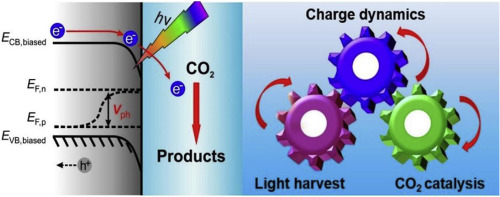Materials Today Nano ( IF 10.3 ) Pub Date : 2020-03-29 , DOI: 10.1016/j.mtnano.2020.100077 P. Ding , T. Jiang , N. Han , Y. Li

|
Photoelectrochemical (PEC) CO2 reduction integrates the merits of photocatalysis and electrolysis and represents an effective route to realize the solar-driven production of chemical fuels from CO2 reduction. Over recent years, tremendous efforts have been devoted to the design and engineering of photocathodes so as to improve their PEC performances with many exciting progresses. Herein, we provide a review on the latest advances in this field. We first introduce the fundamental working principle, current challenges, and performance figures of merits of PEC CO2 reduction. It is then followed by detailed discussion about a number of strategies for photocathode engineering aiming to promoting the three key reaction steps: light absorption, charge separation/transport, and surface catalytic reaction. Finally, we present a brief conclusion and perspective about possible future research directions of this field.
中文翻译:

光电阴极工程技术可有效降低光电化学CO 2排放
光电化学(PEC)CO 2还原技术集光催化和电解的优点于一身,是实现太阳能驱动的CO 2还原法生产化学燃料的有效途径。近年来,人们为光电阴极的设计和工程做出了巨大的努力,以通过许多令人振奋的进步来提高其PEC性能。在此,我们将对这一领域的最新进展进行回顾。我们首先介绍PEC CO 2的基本工作原理,当前挑战和性能指标。减少。随后,将详细讨论光阴极工程的许多策略,这些策略旨在促进三个关键反应步骤:光吸收,电荷分离/传输和表面催化反应。最后,我们给出了该领域可能的未来研究方向的简要结论和观点。



























 京公网安备 11010802027423号
京公网安备 11010802027423号